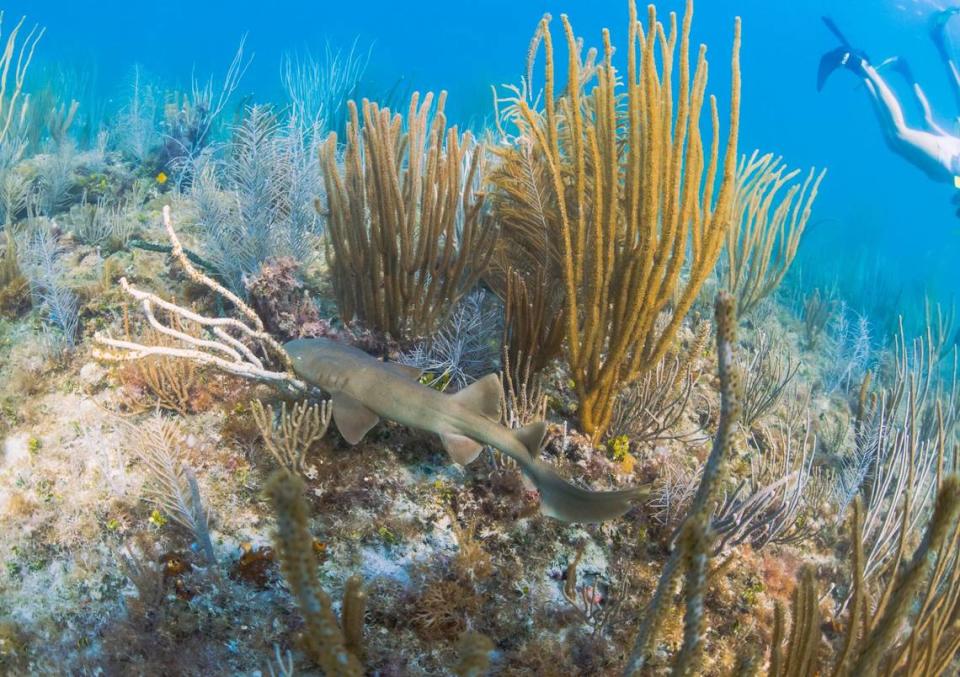Are shark attacks on the rise in Florida this year? Here’s what the experts say
A man was spearfishing along a reef off Key West when a bull shark swam up and bit him this past Monday. It’s just one of the latest in the string of shark attacks this summer.
On July 8, a 14-year-old boy was training to be a lifeguard at Ponce Inlet and dove onto a shark, causing it to bite his right calf. On July 4, a 21-year-old Ohio man was bitten on his right foot at New Smyrna Beach while playing football in shallow water. A day later, a 26-year-old Sarasota man was wading in an inner tube at the same beach when a shark bit his left foot.
All these incidents dominating your news coverage might lead you to think that shark attacks are on the rise. But before you freak out and start humming the “Jaws” theme every time you go to the beach, shark experts say that this year’s amount of attacks is nothing out of the ordinary.
Stephen Kajiura, a professor of biological sciences at Florida Atlantic University and shark expert, said that this year is on par with any other year.
“Don’t let fear of sharks prevent you from having a good time. The chances of you being bitten are so tiny, so minuscule,” Kajiura said. “If they wanted to eat us there’d be carnage out there. But, we are not part of their menu.”
In 2023, the Florida Museum of Natural History’s International Shark Attack File investigated 120 worldwide alleged shark-human interactions. It confirmed 69 unprovoked and 22 provoked shark bites on humans. What’s the difference between the two? Unprovoked bites happen when the shark initiates the incident, while provoked is vice versa.
These numbers are in line with the past five years’ averages. Annual totals typically fluctuate from year to year due to weather patterns, coastline human activities and other influences, according to the museum.

There is no official tally of shark attacks for 2024 yet, but one shark tracking website has a shark attack map for 2024 claiming that there have been 39 attacks (both provoked and unprovoked) as of July 10. Kajiura said that this number seems about right but that the International Shark File will have the best up-to-date information on attacks.
Gavin Naylor, director of the Florida Program for Shark Research, said the official tally takes a while because scientists differentiate between provoked and unprovoked attacks. But he agrees with Kajiura and says numbers for this time of year are normal.
“I tell people if sharks targeted people we would have 10,000 bites a day,” Naylor said.
So why do sharks bite humans unprovoked? Well, Kajiura believes sometimes it’s purely accidental.
“I think what happens here is people are going to the beach, splashing around, having a good time, when the shark comes along, and it makes a mistake,” he said. “It sees the shiny sole of the palm of your hand in water, and it thinks that it looks like a little shiny bait fish, and it rushes in and gives you a bite and quickly realizes you don’t taste at all like what we want. And so the shark goes away, because we’re not their typical sort of food item”
Florida is the champion for most shark attacks because of its coastline and how its waters stay warmer longer than other states. This is also why shark activity is at its peak in Florida waters April through October, according to the Florida Fish and Wildlife Conservation Commission.
However, the locations of shark attacks could shift north in the near future.
Shark attacks might lessen in Florida and rise in northern parts of the country due to climate change, studies suggest. Kajiura has studied migratory Blacktip sharks that normally would come to South Florida in the winter and migrate north in the summer due to temperature changes, like the typical snowbird.
“What we found now is that with water temperatures rising and the oceans getting warmer, these sharks are going farther north than they did before, because the water is warmer farther north now, and so they can go all the way up to like New York now and you see them off Long Island when we never used to see that before,” he said. “They’re also not coming as far south to Florida like they used to.”

